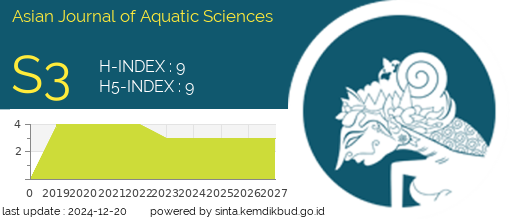Feasibility Assessment of Mangrove in Two Villages on Bengkalis Island for Ecotourism
DOI:
https://doi.org/10.31258/jnat.21.1.75-80Keywords:
Mangrove Ecosystem, Tourism Suitability Index, Ecotourism FeasibilityAbstract
Mangroves are a unique ecosystem that has an important role both bio-physically and socio-economically. Unfortunately, this ecosystem has suffered damage due to various forms of unwise use. Alternatively, the use of mangroves for ecotourism is often seen as more environmentally friendly and sustainable. On the other hand, some factors limit the success of mangrove ecotourism management. One of the most important factors is the feasibility of the mangrove itself as a capital for ecotourism. This study aims to evaluate the characteristics of mangroves in two villages on Bengkalis Island as ecotourism resources and to analyze their suitability as an ecotourism attraction. Data were collected through direct observation and interviews in Kuala Alam and Pematang Duku Village in Bengkalis District, Bengkalis Regency, Riau Province. The feasibility is analyzed using the Tourism Suitability Index (TSI) based on parameters that have been set by the TSI. The mangroves in Kuala Alam have an average cover thickness of 337 m, with a density of 300 trees/ha, which are composed of nine tree species. Mangroves in Pematang Duku have an average cover thickness of 948 m, with a density of 500 trees/ha, consisting of 14 tree species. The mangrove fauna found in the two villages is generally the same, as with the tidal pattern. The mangroves in Kuala Alam Village achieve a score of 1.75 which means they do not have tourism suitability (TSI<2) while mangroves in Pematang Duku achieve a score of 2.38 which meet the criteria to develop mangrove ecotourism (TSI>2).
Downloads
References
Agustini, N.T., Ta’alidin, Z., Purnama, D., 2016. Struktur Komunitas Mangrove di Desa Kahyapu Pulau Enggano. Jurnal Enggano, 1(1): 19-31.
Friess, D.A., 2017. Ecotourism as a Tool for Mangrove Conservation, Sumatra Journal of Disaster, Geography and Geography Education, 1(1): 24-35
Kustanti, A., 2011. Manajemen Hutan Mangrove. IPB Press, Bogor.
Noor, Y.R., Khazali, M., Suryadiputra, I.N.N., 2006. Panduan Pengenalan Mangrove di Indonesia. Wetland International Indonesia.
Setyabudi, I., Permana, D.A., 2020. Evaluasi Kualitas Visual Lanskap di Kawasan Hutan Mangrove Sukadana Kabupaten Kayong Utara. Aksen 4, 19–30. https://doi.org/10.37715/aksen.v4i2.1312
Supardjo, M.N., 2008. Identifikasi Vegetasi Mangrove di Segoro Anak Selatan, Taman Nasional Alas Purwo, Banyuwangi, Jawa Timur. Jurnal Saintek Perikanan, 3(2): 9-15.
Syah, A.F., 2020. Penanaman Mangrove sebagai Upaya Pencegahan Abrasi di Desa Socah. Jurnal Ilmiah Pangabdhi 6, 13–16. https://doi.org/10.21107/pangabdhi.v6i1.6909
Yulianda, F., 2019. Ekowisata Perairan. IPB Press, Bogor.






